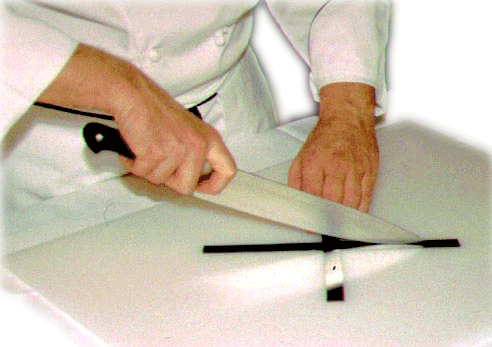 There are two basic techniques for use of the French
knife:
There are two basic techniques for use of the French
knife:

1. Pivot point technique - accomplished by using
the point end of the knife as a pivot. By maintaining contact of the point
of the front of
the knife to the cutting board, the knife can then be arched up and down
in a chopping motion.
2. Free pass technique - accomplished by raising
the entire knife from the board and then returning it in an up-and-down
motion.
With those two basic techniques, there are three
basic movements of the knife:
1. Straight down - when the knife is moved up and
down by using either the pivot technique or the free pass technique.
2. Down and back movement
3. Down and forward movement
These may be combined with the pivot technique. The
knife slides forward or backward in a slicing motion utilizing a greater
portion of the blade than in the straight down motion. This motion may
also be used with the free pass technique when cutting, slicing, or
chopping.
It is also important to remember that the maximum power
of the knife is achieved at the area nearest the handle, so harder or more
dense materials may be cut from this area. Finer cutting of soft items,
such as mushrooms, may be executed by using the tip of the blade.
A solid foundation or positioning is necessary to
accomplish consistency in production. Stand straight with your weight
evenly distributed on both feet. Stand as close to the work bench as
possible without touching it. Then, place your feet at about a 20-degree
angle with your heels approximately six inches apart. Remain relaxed.
If heavy duty cutting is required, you may wish to place
your feet at a 45-degree position for more power








